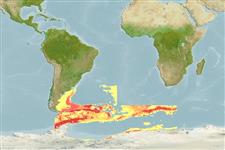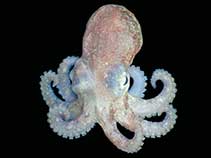Pareledone turqueti (Joubin, 1905)
Turquet's octopus| Native range | All suitable habitat | Point map | Year 2050 |

|
| This map was computer-generated and has not yet been reviewed. |
| Pareledone turqueti AquaMaps Data sources: GBIF OBIS |
Classification / Names Populärnamn | synonymer | CoL | ITIS | WoRMS
Cephalopoda | Octopoda | Octopodidae | Eledoninae
Environment: milieu / climate zone / djupintervall / distribution range Ekologi
; djupintervall 0 - 4000 m (Ref. 96968). Temperate; 33°S - 83°S, 79°W - 28°E
Distribution Länder | FAO områden | Ekosystem | Förekomster | Utplanteringar
Southern Atlantic and Antarctic.
Length at first maturity / Size / Weight / Age
Könsmognad: Lm ? range ? - ? cm Max length : 18.0 cm TL hane/ej könsbestämd; (Ref. 96968)
Life cycle and mating behavior Könsmognad | Reproduktion | Lek | Eggs | Fecundity | Larvae
Main reference
referenser | Koordinator | Medarbetare
Collins, M.A., A.L. Allcock and M. Belchier 2004 Cephalopods of the south Georgia Slope. Journal of the Marine Biological Association of the United Kingdom 84:415-419. (Ref. 1975)
IUCN Red List Status
(Ref. 130435: Version 2025-1)
CITES status (Ref. 108899)
CMS (Ref. 116361)
Threat to humans
Human uses
| FishSource |
Verktyg
Ytterligare information
Max. ages / sizes
Length-weight rel.
Length-length rel.
Length-frequencies
Mass conversion
Abundans
Internet-källor
BHL | BOLD Systems | CISTI | DiscoverLife | FAO(Publication : search) | Fishipedia | GenBank (genome, nucleotide) | GloBI | Gomexsi | Google Books | Google Scholar | Google | PubMed | Tree of Life | Wikipedia (Go, sök) | Zoological Record



